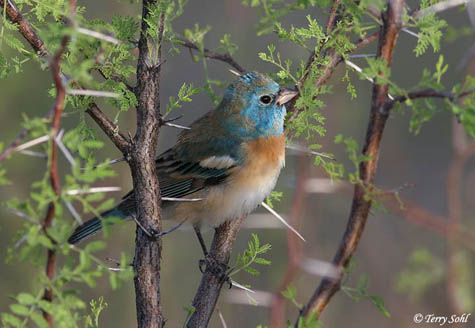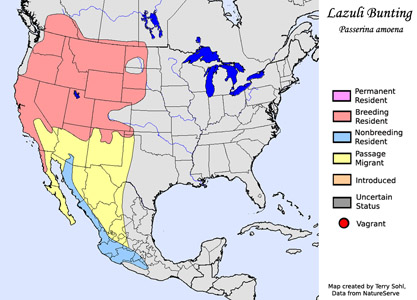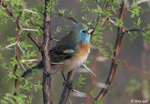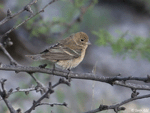| Length: 5.5 inches | Wingspan: 8.5 inches | Seasonality: Summer/Migrant |
| ID Keys (Male): Sky-blue upperparts, rusty chest, white belly, white wing-bars. | ||
 Lazuli Buntings are birds of brushy areas, and have actually
benefited from the brushy habitats which often are the result of forest cutting
activities. They are the western counterpart to the East's Indigo
Bunting. Their ranges overlap in South Dakota, and the two species
often interbreed. The brilliantly colored male is shown to the right,
while a photo of the drabber female can be seen on the bottom of the page.
Lazuli Buntings are birds of brushy areas, and have actually
benefited from the brushy habitats which often are the result of forest cutting
activities. They are the western counterpart to the East's Indigo
Bunting. Their ranges overlap in South Dakota, and the two species
often interbreed. The brilliantly colored male is shown to the right,
while a photo of the drabber female can be seen on the bottom of the page.
Habitat: Prefers brushy areas, including streamside thickets, brushy fields, brushy undergrowth along woodland edges, and sometimes in sagebrush habitats.
Diet: Eats both seeds and insects. The summer diet includes a great many insects, and spiders, as well as the seeds of grasses and weeds, and waste grain. The winter diet is primarily seeds and grains.
Behavior: Usually forages on the ground or by moving through low vegetation. Males are often seen singing in the open, while females tend to stay hidden in cover.
Nesting: May and June
Song: High crisp warbling.
Migration: Summers throughout much of the western United States. Primarily winters in western Mexico.
Interactive eBird Map: Click here to access an interactive eBird map of Lazuli Bunting sightings
Similar Species: Indigo Bunting, Blue Grosbeak. See the Identification Tips page for differentiating between these species.
Conservation Status: Stable in most areas. Numbers are locally much higher than historical levels, due to the brushy second-growth habitat that often results from forest cutting activities.
Bird Feeders: Will attend feeders for small grains and seeds.
Further Information: 1) USGS Patuxent Bird Identification InfoCenter, Lazuli Bunting
3) Audubon Guide - Lazuli Bunting
Photo Information: May 6th, 2008 - Near Tucson, Arizona - Terry Sohl
Additional Photos: Click on the image chips or text links below for additional, higher-resolution Lazuli Bunting photos.
| Click on the map below for a higher-resolution view |
 |
| South Dakota Status: Uncommon migrant and summer resident in the western half of the state. Accidental in the eastern half. |
Additional Lazuli Bunting Photos
Click for a higher-resolution version of these photos



